Ohio is one of only three states that does not include a fish on its list of official state animals (Indiana and Iowa are the others). That is a bit surprising, considering the number of anglers in the Buckeye State and their importance to the state’s economy. Fishing on Lake Erie alone is estimated to pump a billion dollars into the Ohio economy each year. But, state fish or no state fish, Ohio is still a great place to cast a line. While an exhaustive list would be nearly impossible, here’s a look at 44 of the best fishing lakes in the state (some of the lakes appear on the list multiple times, but all lakes were only counted once.)
Bass Lakes
The largemouth bass is the most popular freshwater gamefish in the United States. Ohio has plenty of lakes to catch lunker largemouths. Smallmouth bass can also be caught in most of these lakes, as well. Both largemouth and smallmouth bass are native to Ohio and can be found in all of the state’s 88 counties.
The Ohio Department of Natural Resources (ODNR) ranked the top three bass lakes in the state.
- Portage Lakes (Summit County)
- The Lakes and Ponds of the Appalachian Hills Wildlife Area (Muskingum, Morgan, Guernsey, and Noble counties)
- Alum Creek Lake (Delaware County)
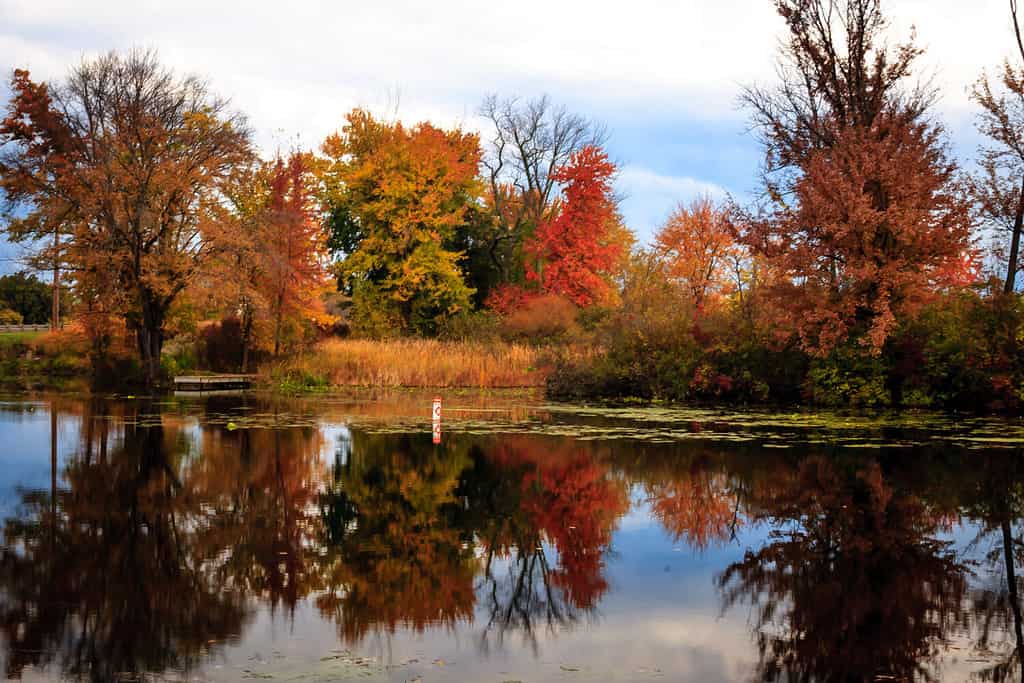
Portage Lakes are not only beautiful, but they are also prime for Ohio bass fishing.
©James Marciniak/Shutterstock.com
Other great lakes for bass fishing in Ohio include:
- Nimisila Reservoir (Summit County)
- Mosquito Creek Lake (Trumbull County)
- Clear Fork Reservoir (Richland and Morrow counties)
- Hoover Reservoir (Delaware and Franklin counties)
- Upper Sandusky Reservoir 2 (Wyandot County)
- Wellington Reservoir (Lorain County)
- Mogadore Reservoir (Portage County)
Catfish Lakes
Channel, flathead, and blue catfish are native to Ohio’s rivers and streams, but they are also stocked in many Ohio lakes. ODNR stocks hundreds of thousands of catfish in lakes and reservoirs throughout the state.
Some of the lakes that have the highest concentrations of catfish include:
- Clendening Lake (Harrison County)
- Hoover Reservoir (Delaware and Franklin counties)
- Caesar Creek Reservoir (Warren County)
- Seneca (or Senecaville) Lake (Noble and Guernsey counties)
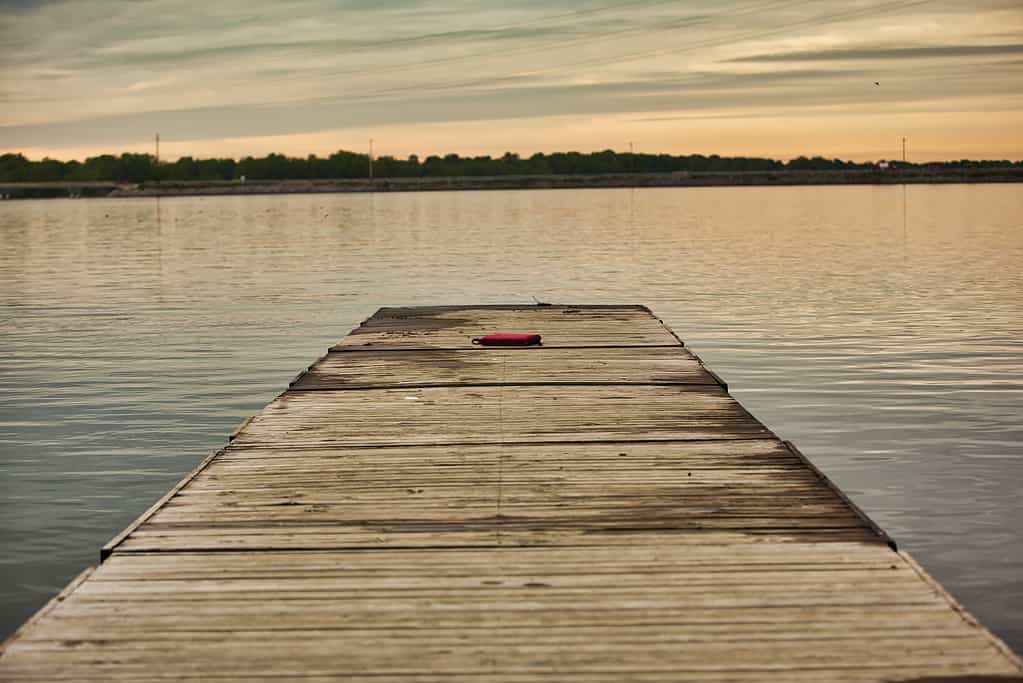
Hoover Reservoir is a fantastic place for Ohioans to catch big catfish.
©aceshot1/Shutterstock.com
Other great places to hook some “whiskers” include:
- Buckeye Lake (Fairfield, Licking, and Perry counties)
- Findlay Reservoirs 1 and 2 (Hancock County)
- Charles Mill Reservoir (Ashland and Richland counties)
- Atwood Lake (Carroll and Tuscarawas counties)
- Piedmont Lake (Belmont and Harrison counties)
- Salt Fork Lake (Guernsey County)
- East Fork Lake (Clermont County)
Crappie Lakes
Crappies are some of the most popular panfish among Ohio anglers. These fish are plentiful and can often be caught in large numbers. They are also some of the most sought-after freshwater fish for table fare. Other tasty panfish, such as bluegill, can typically be caught in the same waters. That adds up to one fantastic fish fry!
ODNR ranks the top three Ohio crappie lakes as follows:
- Mosquito Creek Lake (Trumbull County)
- Indian Lake (Logan County)
- Alum Creek Lake (Delaware County)

You can have a serious fish fry after a day of crappie fishing in Mosquito Creek Lake.
©Margaret Luzier, U.S. Army Corps of Engineers / This image or file is a work of a U.S. Army Corps of Engineers soldier or employee, taken or made as part of that person’s official duties. As a work of the U.S. federal government, the image is in the public domain. – Original
Some other lakes where Ohioans often hook slab crappies include:
- Hoover Reservoir (Delaware and Franklin counties)
- Pymatuning Reservoir (Ashtabula County; three-quarters of the lake lies in Pennsylvania)
- West Branch Reservoir (Portage County)
- Leesville Lake (Carroll County)
- Berlin Lake (Mahoning, Portage, and Stark counties)
- Delaware Lake (Delaware County)
- Salt Fork Lake (Guernsey County)
- Rocky Fork Lake (Highland County)
Hybrid Striped Bass Lakes
The hybrid striped bass (or “striper”) is a cross between the white bass and the striped bass. They are some of the hardest-fighting fish found in Ohio, making them a favorite target for the state’s anglers.
ODNR stocks hybrid striped bass in the Ohio River, as well as the following lakes.
- Buckeye Lake (Fairfield, Licking, and Perry counties)
- Charles Mill Lake (Ashland and Richland counties)
- Dillon Lake (Muskingum County)
- East Fork Lake (Clermont County)
- Griggs Reservoir (Franklin County)
- Kiser Lake (Champaign County)
- O’Shaughnessy Reservoir (Delaware County)
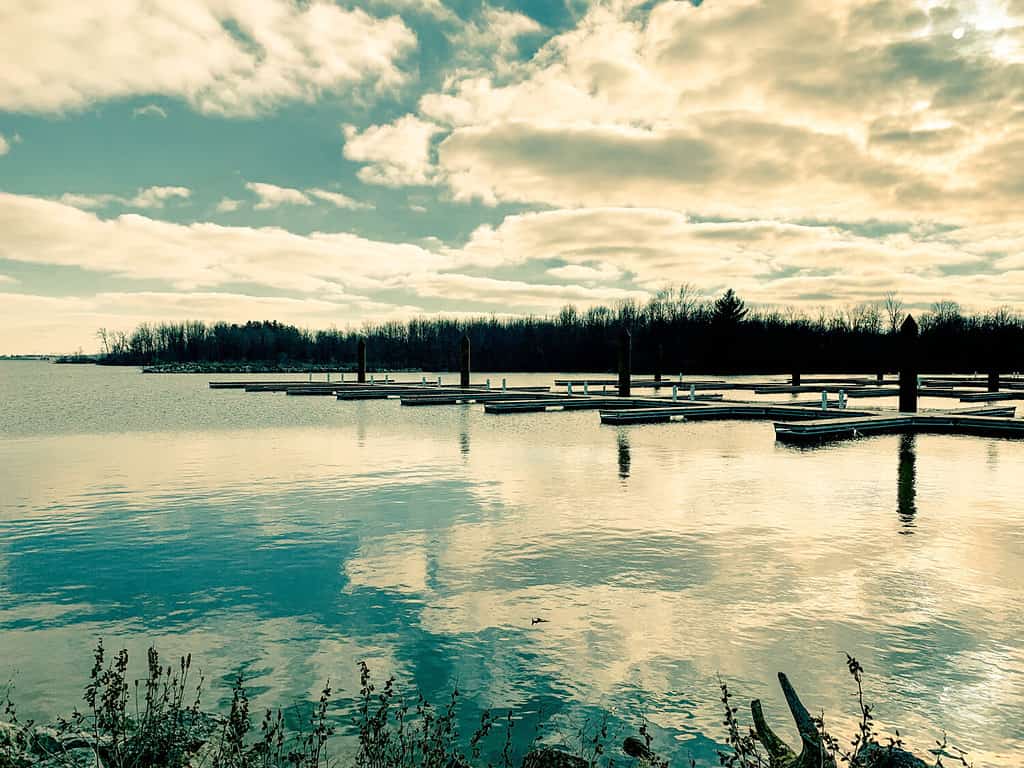
It’s hard to beat Buckeye Lake for striper fishing in Ohio.
©Tara Ballard/Shutterstock.com
Other lakes to hook Ohio stripers include:
- Lake Erie
- Guilford Lake (Columbiana County)
- Deer Creek Lake (Fayette and Pickaway counties)
- Seneca (or Senecaville) Lake (Guernsey and Noble counties)
- West Branch Reservoir (Portage County)
Muskellunge Lakes
Muskellunge ( or muskies) are native to both the Ohio River and Lake Erie drainage basins. They proliferated these regions through the early to mid-1800s. Urbanization and pollution decimated the muskie population in Ohio. These fish were rarely found in the state until a restoration project began in 1952. Thanks to these ongoing efforts, the muskie has staged quite a comeback in Ohio. ODNR lists these nine lakes as the best muskie lakes in the state.
- Leesville Lake (Carroll County)
- Piedmont Lake (Belmont and Harrison counties)
- Clear Fork Reservoir (Morrow and Richland counties)
- West Branch Reservoir (Portage County)
- Cowan Lake (Clinton County)
- Salt Fork Lake (Guernsey County)
- Alum Creek Lake (Delaware County)
- Lake Milton (Mahoning County)
- Pymatuning Reservoir (Ashtabula County)
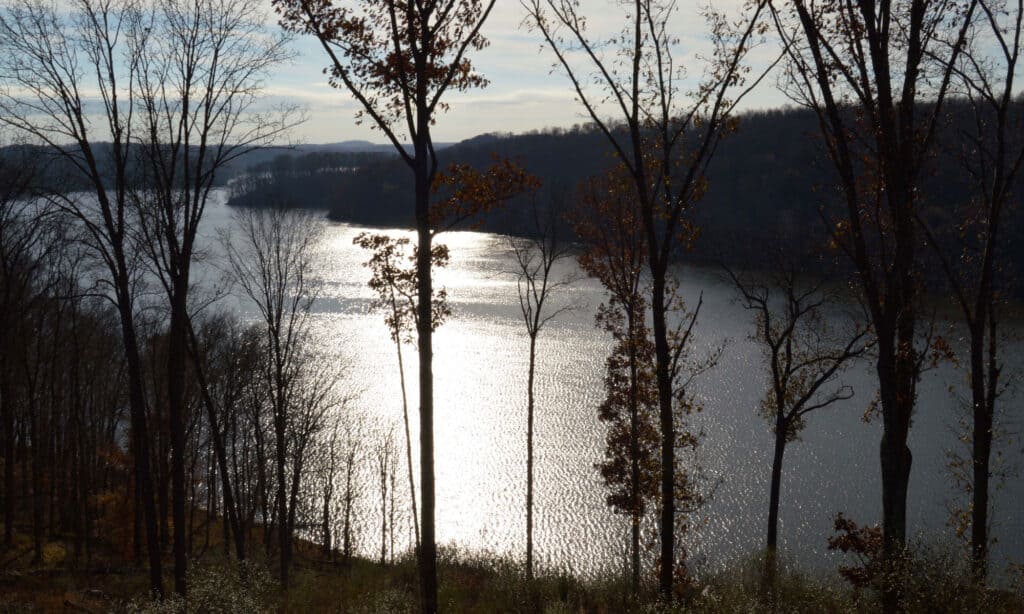
Looking to hook a muskie? Head to Salt Fork Lake.
©ashleykirkpatrick/Shutterstock.com
Saugeye Lakes
A saugeye is a hybrid cross between a walleye and a sauger. This hybridization occasionally occurs naturally, but most of the saugeye in Ohio waters were crossbred and stocked by ODNR.
Sauger, one of the parent fish of the saugeye, is commonly targeted by anglers in the Ohio River and its larger tributaries. The fish once proliferated in Lake Erie, as well, but the population has fallen far from its historic numbers. Walleye, the other parent fish of the saugeye hybrid, is discussed below.
Saugeye are highly adaptable and can thrive in rivers, streams, and lakes. The fish are stocked in lakes and reservoirs throughout the state. Since they often move over or through dams, they also populate the tailwaters of many reservoirs. Some of the prime saugeye lakes in Ohio include:
- Indian Lake (Logan County)
- Buckeye Lake (Fairfield, Perry, and Licking counties)
- Alum Creek Lake (Delaware County)
- Salt Fork Lake (Guernsey County)
- Atwood Lake (Carroll and Tuscarawas counties)
- East Fork Lake (Clermont County)
- Charles Mill Reservoir (Ashland and Richland counties)
- Piedmont Lake (Belmont and Harrison counties)
- Tappan Lake (Harrison County)
- Hoover Reservoir (Delaware and Franklin counties)

Atwood Lake is a great place to target saugeye.
©Karl Zhong/Shutterstock.com
Walleye Lakes
As mentioned at the beginning, Ohio does not have a state fish. There have been multiple attempts to name an official fish for the state, though. Most of the recent efforts to name a state fish have centered on the walleye since Lake Erie is considered by many to be the walleye capital of the world. Walleye are also found in the Ohio River, but they are far outnumbered by sauger. Along with Lake Erie, walleye can also be found in some inland reservoirs and lakes throughout Ohio. Some of those lakes include:
- La Due Reservoir (Geauga County)
- C.J. Brown Reservoir (Clark County)
- Berlin Lake (Mahoning, Portage, and Stark counties)
- Pymatuning Reservoir (Ashtabula County)
- Mosquito Creek Lake (Trumbull County)
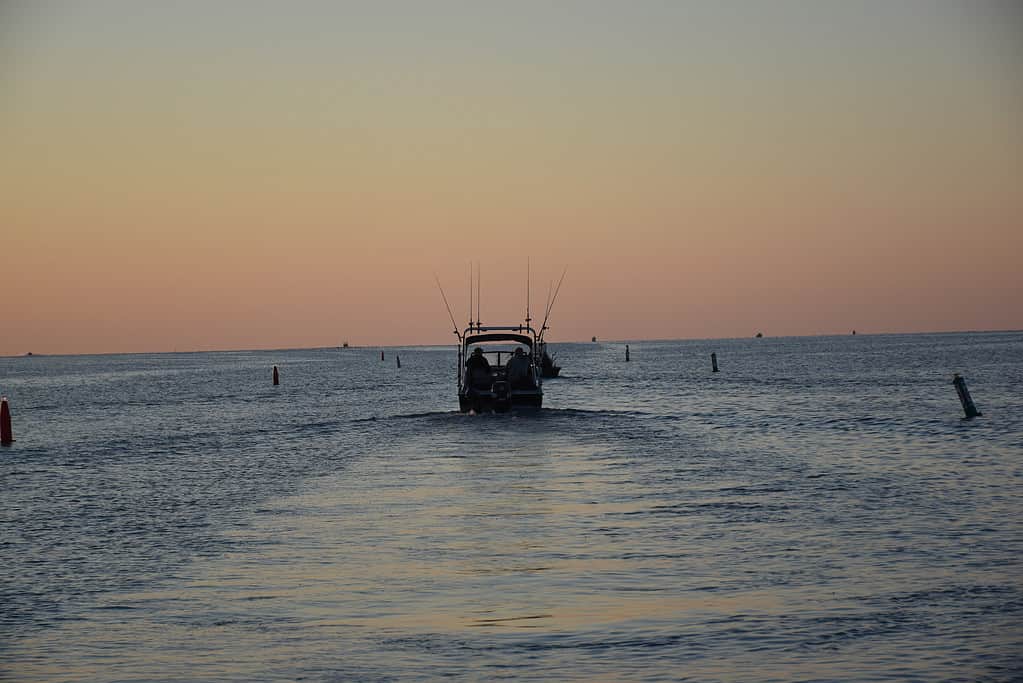
Lake Erie is one of the world’s premier lakes for walleye fishing.
©iStock.com/gnatoutdoors
Yellow Perch Lakes
The yellow perch is a native Ohio fish that has been in high demand historically due to the mild, sweet flavor of its filets. Ohio fishers used to catch yellow perch in high numbers, especially in Lake Erie. Invasive species, environmental issues, and overfishing have caused a drop in the lake’s yellow perch population. Monitoring and conservation efforts are underway to restore the yellow perch in the Lake Erie fishery. Along with Lake Erie, several of Ohio’s inland lakes also feature yellow perch. Some of those lakes include:
- Pymatuning Reservoir (Ashtabula County)
- Mogadore Reservoir (Portage County)
- Wingfoot Lake (Portage County)
- Ferguson Reservoir (Allen County)
- Metzger Reservoir (Allen County)
- Wauseon Reservoir #2 (Fulton County)
- Defiance Reservoir (Defiance County)

While most of Pymatuning Reservoir is in Pennsylvania, it is still a prime fishery in Ohio.
©Kody L Beer/Shutterstock.com
The photo featured at the top of this post is © Bwsmith84 at English Wikipedia / CC BY 3.0 – License / Original
Thank you for reading! Have some feedback for us? Contact the AZ Animals editorial team.







